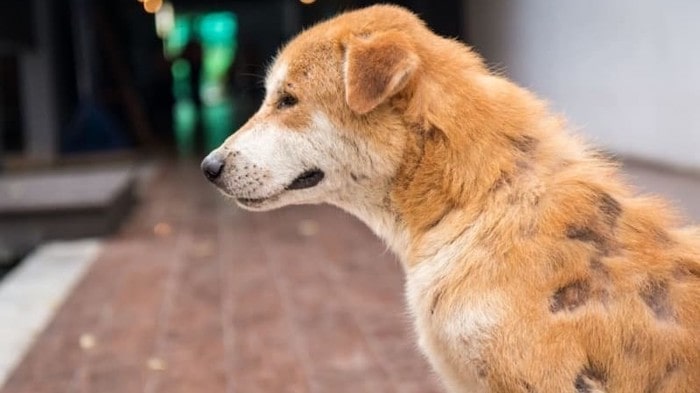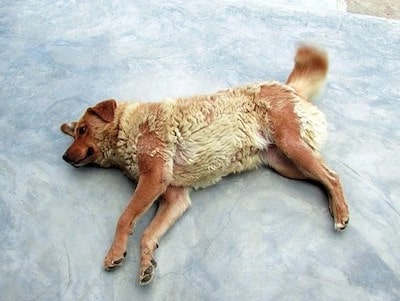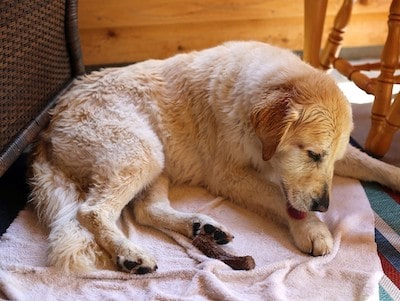While slight hair loss is common in pets as it is in humans, severe hair thinning with bald patches is not. It is a condition known as alopecia. Hair fall is a normal part of the hair growth cycle, but alopecia is a severe condition that requires medical attention.
If you’re concerned that your dog may have alopecia, it might be time to look for some signs or visit a vet. Fortunately, alopecia is treatable, so you don’t have to worry about anything. And in this blog post, we will explore why dogs get alopecia, how to identify it, and its treatments. So, let’s dive right into it!
What is Alopecia?
Alopecia refers to the hair fall in which the dogs can’t regrow their hair. Partial or complete hair fall, alopecia is not life-threatening, and your dog may be able to live their lives.

The only matter of concern is the itchiness. You don’t want your dog to go crazy trying to scratch its skin, forming wounds or worse. This alopecia can be in the form of hair thinning, bald patches, or overall coat deterioration: all indicative of an underlying issue.
Causes of Alopecia in Dogs
Alopecia could be due to any reason: skin problems, hormones, or allergies. We shall discuss these causes in more detail down below;
1) Allergies: Food allergies or access to certain environmental factors (pollen and dust mites) can induce skin allergies. An outdoor environment that is hot, dirty, or moist can also cause skin infestations in dogs.
Some grooming products can trigger an allergic reaction in your fluffy. Hence, we recommend purchasing products that are pet friendly and specifically breed-friendly. Identifying the allergen (food or environment) and stopping it can help resolve the issue.
2) Hormonal Imbalances: Hormonal imbalances in dogs can be a significant reason for skin problems. High cortisol, low thyroid levels, or a reaction to some vaccines can weaken the immune system.
This weak immunity leads to itchy skin, causing the dog to scratch in discomfort and, thus, the open wound. Toy Poodles, Samoyeds, and Yorkshire Terriers are some breeds prone to hair loss due to hormonal imbalances.

3) Parasites: If a parasite is the culprit, you may or may not see it. Fleas, ticks, and lice can be seen with the naked eye and are a common cause of alopecia. On the other hand, mites or other fungi cannot be seen but can be your fugitive. In both cases, the dog may find severely irritating skin.
4) Nutritional Deficiencies: Diet is another common factor leading to unusual hair loss. Inadequate diet, starvation, or vitamin deficiencies can impact your puppy, including their fur’s health. Keep a check on your dog’s diet and keep it as healthy as possible.
Try providing all the essential nutrients (proteins, fatty acids, or vitamins). They are crucial for their coat health and general livelihood.
5) Stress: As humans experiencing anxiety can suffer from hair loss, dogs can too. When dogs feel more anxious, they tend to suffer from more frequent hair loss, leading to alopecia.
In another scenario, if your dog is constantly scratching due to hormonal imbalance or other reasons, it may trigger their anxiety trying to relieve the discomfort.
This dreadful cycle of stress, because of constant scratching and persistent distress, can lead to alopecia.
While there are these factors causing alopecia, some breeds are more prone to this disorder. These breeds include; Mexican Hairless and Chinese crested. While other dog breeds are genetically inclined, including; Bulldogs, Greyhounds, Dachshunds, Yorkshire Terriers, and Dobermans.
You can reduce or manage the shedding of a few dog breeds, like providing your Yorkshire Terrier with a cute haircut or promoting daily brushing with the best brush for a Goldendoodle. But these tips can be a disaster for some other dogs.
Regular grooming for a Yorkie can help remove loose hair and dander. But for Retriever, this may be a way to “Post Clipping Alopecia.”
Symptoms
If you suspect your dog has alopecia, keep an eye out for the following symptoms
- Red or inflamed skin. It could also be bleeding or turned black in colour
- It has red spots or pimples on the skin
- Weight loss or gain
- dandruff
- Licking and chewing more (over-grooming)
- lethargy
Did you notice the above symptoms or a change in your dog’s behaviour? Consult your vet. Sometimes it is not necessary that your dog may experience itchiness, but the skin may be red or inflamed, and other symptoms will be visible.
Prevention and Management
If your dog is experiencing hair loss, there’s no need to panic. There are many ways to treat and manage alopecia. All you need is a calm mind (so you can calm your canine buddy, too) and give them proper care.
- Consult a Vet: The first step in any treatment is medical attention. We do not recommend home remedies as they can aggravate the situation. Your vet can perform the necessary tests to diagnose the underlying problem. They are capable of suggesting the appropriate treatments for your pup.
- Healthy Diet: Dogs can have hair fall due to lacking in their diets. Consults with the vet and come up with a nutritious food plan. Your vet will recommend supplements or food that support their general health and a healthy coat, depending on their age, breed, and specific needs.

- Regular Grooming: Grooming is necessary to prevent mats and tangles and promote healthy hair. It is also vital because it helps remove loose hair and check your dog’s skin. If you notice anything unusual on your dog’s skin during these grooming sessions, you know whom to ask for advice.
- Anti-Fleas: During this grooming session, include a “check for fleas” session. Fleas are annoying and can make your pet’s life hell. Consider flea preventatives, recommended by your vet. While we can’t completely protect our dogs from fleas (I mean, they have to go outside anyway), we can try to keep these pests at bay.
- Minimize Stress: This is the most obvious one. Create a peaceful environment for your loved one; this goes for your pets too. Create an atmosphere full of love and compassion; that has no place to trigger their stress. Engage with them, and provide mental simulations and physical exercises to keep them active and busy.
Once the underlying cause of the disease is known, it is easier to manage future alopecia. Although not necessarily prevent, you can take preventive measures to control alopecia as much as possible.
Keep the dog clean and groomed, use anti-ticks, and avoid allergens. And if you see any symptoms reoccurring, you can consult your vet quickly before the symptoms progress.
Conclusion
Hair loss can make humans and pets equally furious, and it’s a cause for concern too. Understanding the reason for hair loss is essential. You must know if your dog is shedding because of changing seasons or needs special attention.
Understand the potential cause of alopecia. Is it allergens? Or do you need to check their hormones? Could it be some parasite? Or is your pet on some nutritional deficiency? There are so many potentials causing alopecia to address to resist the root cause.
Identify the problem and take appropriate steps to [event and manage the condition. Although alopecia is a discomforting condition, it is manageable. With proper care and veterinary advice, you can take appropriate measures to address the issue and help your puppy lead a happy and healthy life.

A retired veterinary technician and full-time dog parent. James knows to serve the community with the best of his knowledge of animal healthcare. He has been working in a known veterinary clinic for quite a few years. He loves reading blogs on pet nutrition and writes unbiased reviews of dog products.


